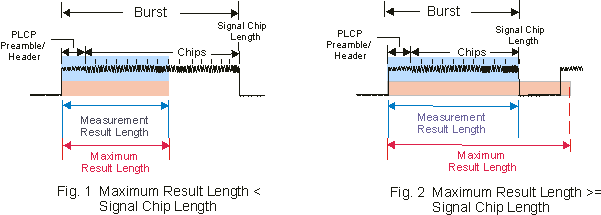About Result Length (802.11b/g DSSS/CCK/PBCC)
Refer to DSSS/CCK/PBCC Preset to Standard table
250,000 chips maximum
Result Length specifies the total number of chips included in the acquired and demodulated data. There are two modes of selecting the Result Length analysis data: and :
When (Default) is selected, the VSA automatically determines the measurement result length. The result length is determined by comparing the input signals chip length to the Maximum Result Length and using the smaller number.
: When is selected, specifies the maximum number of chips that can be included in the measurement result length. The number of chips is rounded to the nearest whole number of data symbols, as determined from the input signals data rate and modulation format.
When the check box is selected, this specifies the measurement result length in chips. The number of chips is rounded to the nearest whole number of data symbols, as determined from the input signal's data rate and modulation format. The VSA ignores the input burst chip length and uses the chip length. The VSA will use this value even if it is longer than the measured signals burst length.
does not limit the result length to the number of chips transmitted within the burst as is done in mode. The VSA will demodulate the total number of chips specified by , which if longer than the burst, could lead to unexpected and incorrect data results.
The result length includes the PLCP Physical layer convergence protocol Preamble and Header. For bursts that use the long format preamble, the first 1584 chips are preamble and the next 528 chips are header, so the data segment of the burst starts at chip number 2112. For bursts that use the short format preamble, the first 792 chips are preamble and the next 264 chips are header, so the data segment of the burst starts at chip number 1056. The PLCP header specifies the length of the data segment of the burst in microseconds. This value must be multiplied by 11 to get the length of the Data segment of the burst in chips.
The formula for determining the burst length when the Long PLCP preamble format:
Burst Length In Chips = 2112 + DataLenInMicroSec * 11
When the Short PLCP Preamble format:
Burst Length In Chips = 1056 + DataLenInMicroSec * 11
To make sure that the entire burst is demodulated, the Result Length parameter should be set to a value at least this large.
Trace Data Results
The and affect nearly all measurement results, including the and trace data, and the region over which EVM Error vector magnitude (EVM): A quality metric in digital communication systems. See the EVM metric in the Error Summary Table topic in each demodulator for more information on how EVM is calculated for that modulation format. is calculated. The only trace data not affected by and are the Error Summary values for Sync Correlation, Frequency Error, Burst Type, Bit Rate, Octets, and Data Length. The "802.11-2007 1000 chip Peak EVM" is computed from the first 1000 chips starting at the .
The default measurement offset is set to 22 chips, which is 2 microseconds at the default chip rate. This is because the 802.11b and 802.11g specifications provide for up to 2 microseconds of ramp-up at the start of the burst. It is generally not desirable to include that ramp-up in the EVM calculations.
Automatic Example
When is selected, the result length is determined by comparing the input signals chip length to and using the smaller number. The chip length is determined from the input signal PLCP Header data.
-
The measurement result length will be set to the value.
-
The measurement result length will default to the number of chips detected within the burst.

Manual Example
does not limit the result length to the number of chips transmitted within the burst as is done in Automatic mode. The VSA will demodulate the total number of chips specified by , which if longer than the burst, could lead to unexpected and incorrect data results.

See Also
About Measurement Interval and Offset (802.11b/g DSSS/CCK/PBCC)
